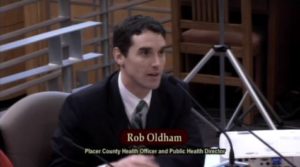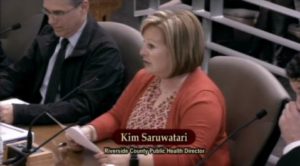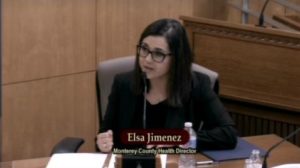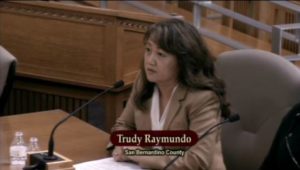Senate Health Committee Holds Informational Hearing on Public Health Infrastructure and Capacity
On Wednesday, the Senate Health Committee convened an informational hearing on the public health infrastructure and capacity. The hearing, chaired by Senator Richard Pan, focused primarily on governmental public health and provided a rare three-hour platform for the state and local health departments to discuss their range of responsibilities and the challenges with addressing key public health issues facing Californians.
The first panel of the hearing consisted of leaders from the California Department of Public Health (CDPH). Dr. Karen Smith, CDPH Director and State Health Officer, discussed the broad responsibilities of CDPH, the state’s reliance on local health departments to carry out many of the CDPH functions at the local level, and foundational public health services. She also referenced her previous experience at the local level during a time where local health departments were facing budget cuts and noted that a loss of workforce at the local level is a real threat to public health. Dr. Gil Chavez, Deputy Director of the Center for Infectious Disease at CDPH, discussed the rising rates of infectious disease cases. He noted that over the last decade, California saw a 45 percent increase in reported cases and highlighted the state and local partnership. Susan Fanelli, Chief Deputy Director for Policy and Programs at CDPH, discussed state and local emergency preparedness activities and key examples of response activities such as those related to the H1N1 outbreak. During the discussion between legislators and CDPH, Dr. Smith did note that the state did not have the capacity to respond to local emergencies with boots on the ground and that trained staff at the local level is critical.


The second panel discussed the role of local health departments, our infrastructure, and challenges. Dr. Rob Oldham from Placer County shared the responsibilities of local health departments. Kim Saruwatari from Riverside County illustrated the planning and preparation that goes into local emergency preparedness activities. Dr. Andy Miller shared Butte County’s recent Camp fire experiences and the role public health played in evacuation requests, infectious disease control, and sheltering support. Lastly, Dr. Sharon Balter shared Los Angeles County’s experiences with the 2017 Hepatitis A outbreak and all the activities that went into ensuring the number of cases remained low.
 The next panel discussed key undertreated diseases of interest to the Legislature and the challenges with our local capacity in addressing them. The panel included a representative from Planned Parenthood discussing the rising STD rates, the role of Planned Parenthood, and potential impacts of the federal Title X regulations. Dr. Anissa Davis from the City of Long Beach discussed the role of the local health department and the prioritization of cases that occurs due to a lack of resources. Dr. Louise McNitt from Contra Costa County discussed the number of tuberculosis cases in California and the intensive case management provided by local health departments. Kimberly Hernandez from Kern County noted the lack of both community and provider knowledge regarding valley fever and the need for resources for investigations and education. Elsa Jimenez from Monterey County discussed the burden of chronic diseases in California, the cost to the health care system and the need for sustainable funding for prevention activities.
The next panel discussed key undertreated diseases of interest to the Legislature and the challenges with our local capacity in addressing them. The panel included a representative from Planned Parenthood discussing the rising STD rates, the role of Planned Parenthood, and potential impacts of the federal Title X regulations. Dr. Anissa Davis from the City of Long Beach discussed the role of the local health department and the prioritization of cases that occurs due to a lack of resources. Dr. Louise McNitt from Contra Costa County discussed the number of tuberculosis cases in California and the intensive case management provided by local health departments. Kimberly Hernandez from Kern County noted the lack of both community and provider knowledge regarding valley fever and the need for resources for investigations and education. Elsa Jimenez from Monterey County discussed the burden of chronic diseases in California, the cost to the health care system and the need for sustainable funding for prevention activities.
 The last panel focused on solutions and investments the State could consider. Trudy Raymundo from San Bernardino County discussed the funding declines since 2007-08 and the need for sustainable and flexible funding. Shamika Ossey, a second-generation public health nurse from Los Angeles County discussed the critical role of public health nurses and need to maintain and grow a viable public health workforce. Megan Crumpler from Orange County talked about the unique role of public health labs, the specialized testing performed, and the capacity to respond rapidly to public health threats. And finally, Haydee Dabritz from Yolo County highlighted technology advances over the last decade to ease compliance with reporting requirements and the need for investments into training and technical assistance in addition to additional staff.
The last panel focused on solutions and investments the State could consider. Trudy Raymundo from San Bernardino County discussed the funding declines since 2007-08 and the need for sustainable and flexible funding. Shamika Ossey, a second-generation public health nurse from Los Angeles County discussed the critical role of public health nurses and need to maintain and grow a viable public health workforce. Megan Crumpler from Orange County talked about the unique role of public health labs, the specialized testing performed, and the capacity to respond rapidly to public health threats. And finally, Haydee Dabritz from Yolo County highlighted technology advances over the last decade to ease compliance with reporting requirements and the need for investments into training and technical assistance in addition to additional staff.
In closing remarks, we were pleased to hear Senator Pan mention the need to figure out both how to fund public health and how to score the downstream costs associated with not doing so. CHEAC is very appreciative of Senator Pan and the Senate Health Committee members and staff for the opportunity to discuss the vital work of local health departments. Those participating did a wonderful job at highlighting the breadth of issues local health departments face, and additional CHEAC Members emphasized statements made earlier in the hearing during public comment.
The agenda and hearing materials can be found here.
A recording of the hearing can be viewed here.